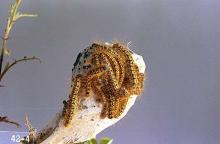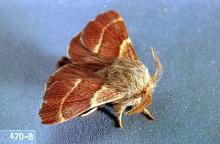Including western tent caterpillar (Malacosoma californicum)
Pest description and crop damage The adult is large-bodied light- to dark-brown moth with a wingspan of 25 mm or more. The larvae of the western tent caterpillar are hairy, dull yellowish brown in color, with a row of blue spots along the side. They live in silken tents constructed in branch crotches and are often found together in large numbers. Larvae feed on leaves and their feeding can defoliate a plant.
Biology and life history Several species of tent caterpillars are found in the Pacific Northwest including the western tent caterpillar, Pacific tent caterpillar (M. constrictum) and forest tent caterpillar (M. disstria). They overwinter as eggs, hatch in spring after bud break, and begin constructing their protective tent. Larvae feed on the foliage for several weeks, maturing in early June. They pupate in silken cocoons near the tent. Adult moths emerge in early summer, mate, and lay eggs in a frothy mass around twigs and small limbs. There is one generation per year.
Management-biological control
Several predatory insects are effective against tent caterpillars, but most years diseases keep their population under control.
Management-cultural control
Destruction of egg masses on limbs, and cutting out tents early in the growing season, will control the caterpillars.
Management-chemical control: HOME USE
Dormant-season spray
- superior-type oil-Some formulations are OMRI-listed for organic use.
Growing-season spray
- azadirachtin -Some formulations are OMRI-listed for organic use.
- Bacillus thuringiensis ssp. kurstaki, strain SA-12/ATCC1323-For use on currants only. Some formulations are OMRI-listed for organic use. For use on currant only.
- bifenthrin
- esfenvalerate-For use on gooseberry only.
- horticultural oils
- insecticidal soap-Some formulations OMRI-listed for organic use.
- plant essential oils (cinnamon, peppermint, rosemary, thyme)-Some formulations are OMRI-listed for organic use.
- pyrethrins (often as a mix with other ingredients)-Some formulations are OMRI-listed for organic use.
- spinosad-Some formulations are OMRI-listed for organic use.
- zeta-cypermethrin
Management-chemical control: COMMERCIAL USE
- azadirachtin (Ecozin and other brands)-Consult label for rate. PHI 0 days. Some formulations are OMRI-listed for organic use.
- Bacillus thuringiensis (Bt) (several brands)-Use according to label directions. PHI 0 days. Some formulations are OMRI-listed for organic use.
- bifenthrin (Brigade 2EC and other brands) at 0.033 to 0.10 lb ai/A. PHI 1 day. Toxic to bees; do not apply when bees are foraging. Also toxic to fish and other aquatic invertebrates. Restricted use pesticide.
- fenpropathrin (Danitol 2.4EC) at 0.2 to 0.3 lb ai/A. PHI 21 days. Do not exceed 0.8 lb ai/A per season. Do not apply during bloom. Restricted use pesticide.
- indoxacarb (Avaunt) at 0.065 to 0.11 lb ai/A. PHI 7 days. Toxic to bees; do not apply when bees are foraging. Also toxic to fish and other aquatic invertebrates.
- methoxyfenozide (Intrepid and others) at 0.16 to 0.25 lb ai/A. PHI 7 days. Apply when egg laying begins and young larvae are present. The effectiveness of methoxyfenozide for controlling this pest has not been determined; but, as it controls other lepidopteran larvae, it may also be effective in controlling tent caterpillars.
- spinetoram (Delegate) at 0.05 to 0.10 lb ai/A. PHI 3 days. Toxic to bees exposed to treatment for 3 hours following treatment. Do not use when bees are foraging. Also toxic to fish and other aquatic invertebrates. The effectiveness of spinetoram for controlling this pest has not been determined; but, as it controls other lepidopteran larvae, it may also be effective for controlling tent caterpillars.
- spinosad (Entrust) at 0.062 to 0.09 lb ai/A. PHI varies by label. Entrust is OMRI-listed for organic use. Apply at egg hatch or to small larvae. Toxic to bees exposed to treatment for 3 hours following treatment. Do not use when bees are foraging. Also toxic to fish and other aquatic invertebrates. The effectiveness of spinosad for controlling this pest has not been determined; but, as it controls other lepidopteran larvae, it may also be effective for controlling tent caterpillars.


